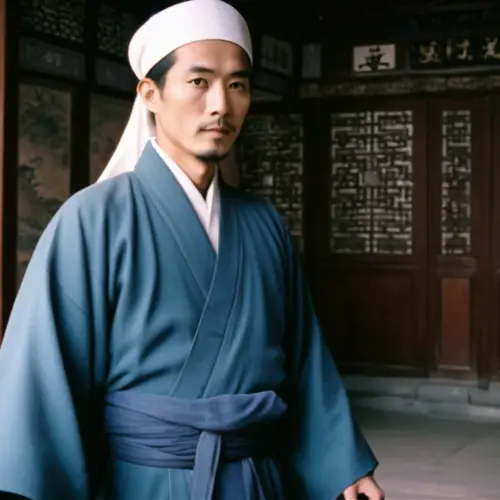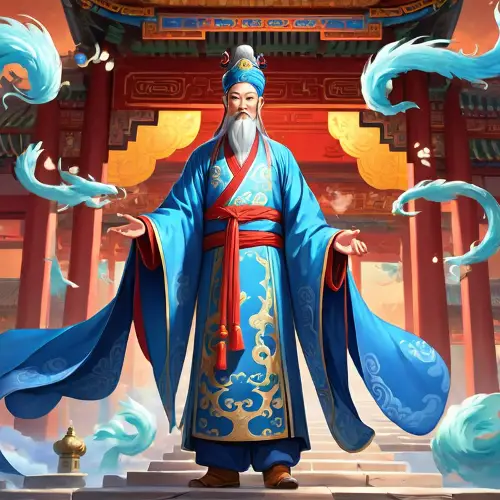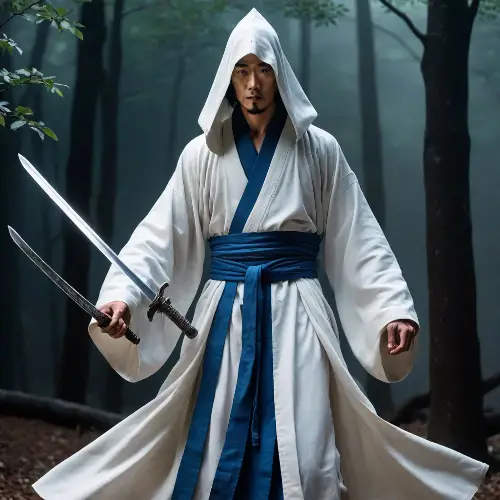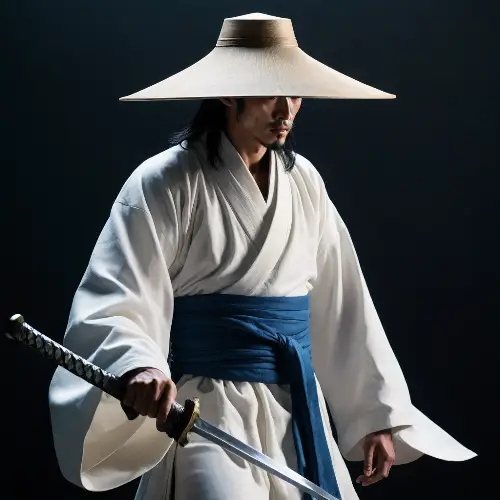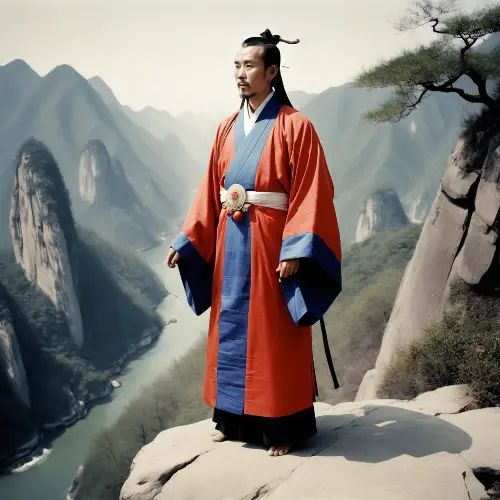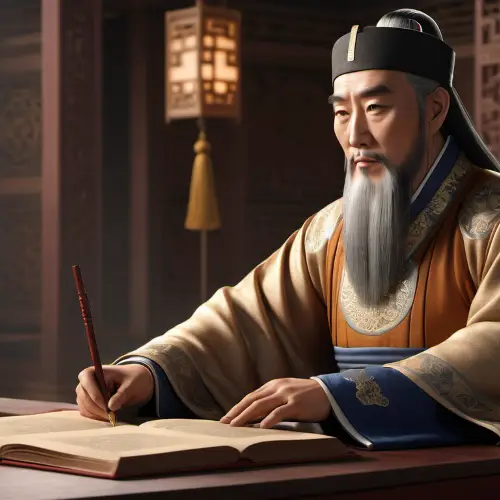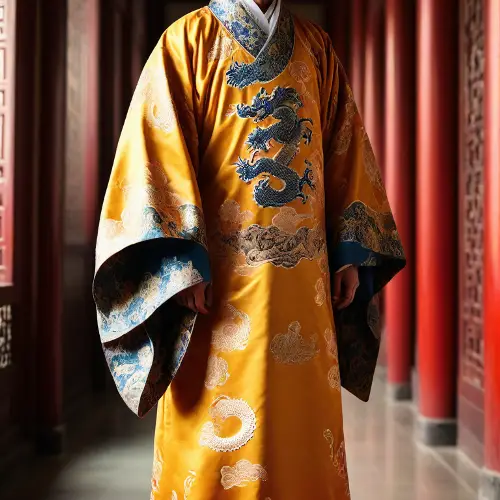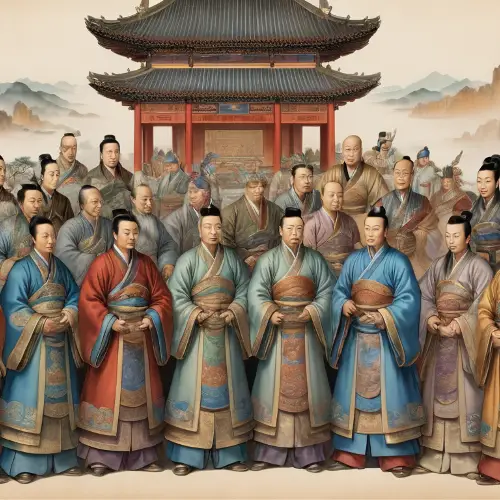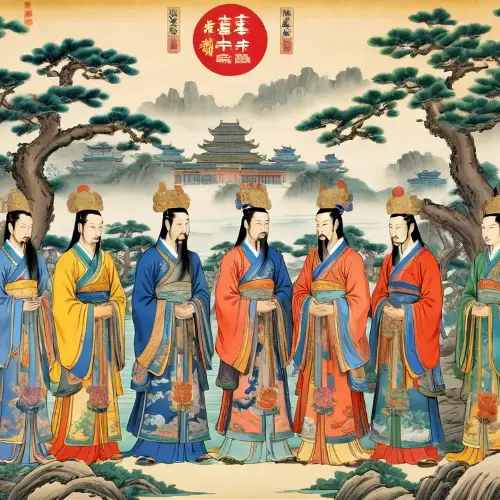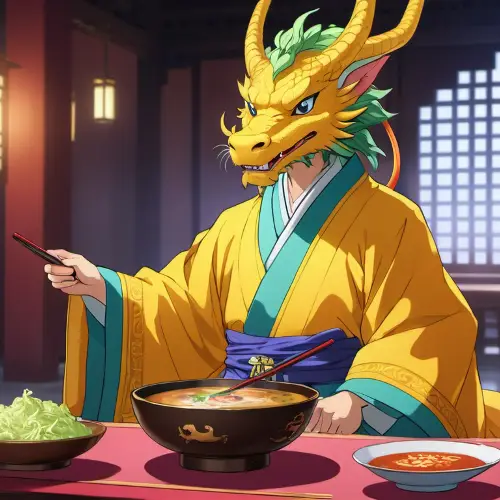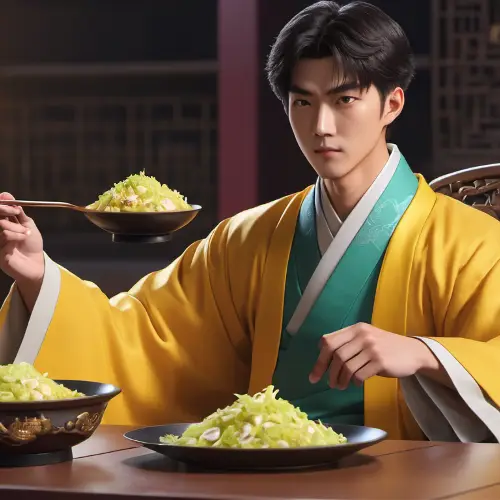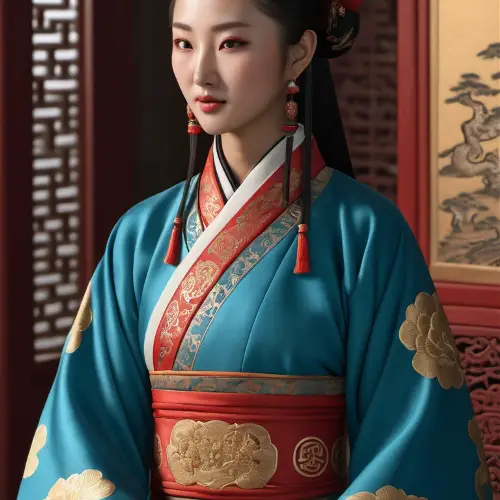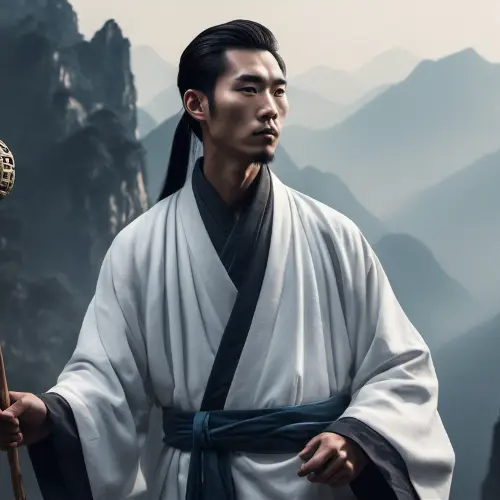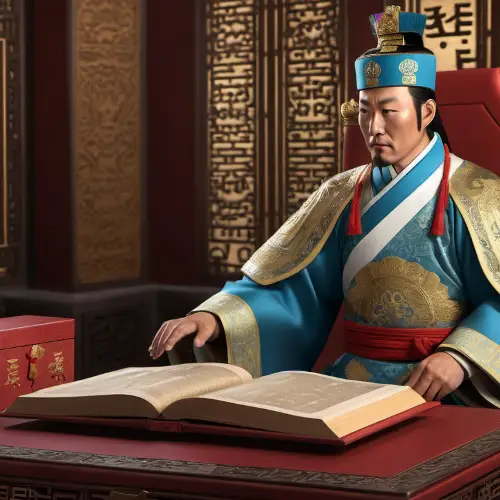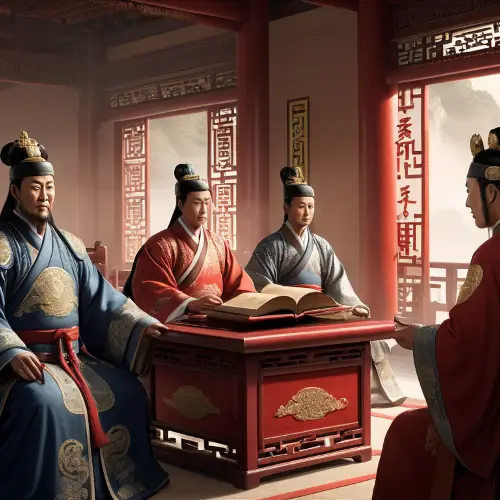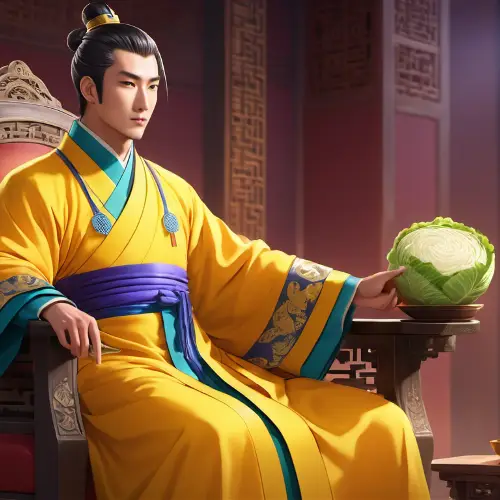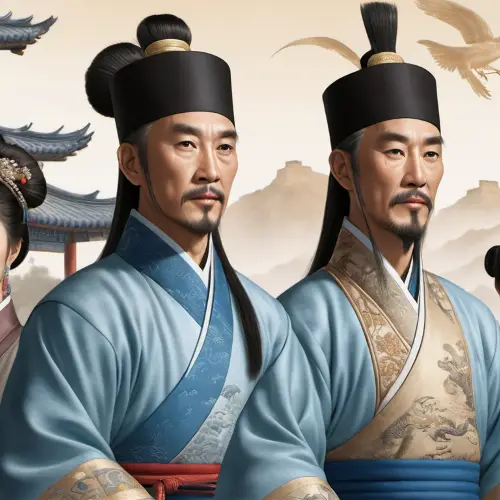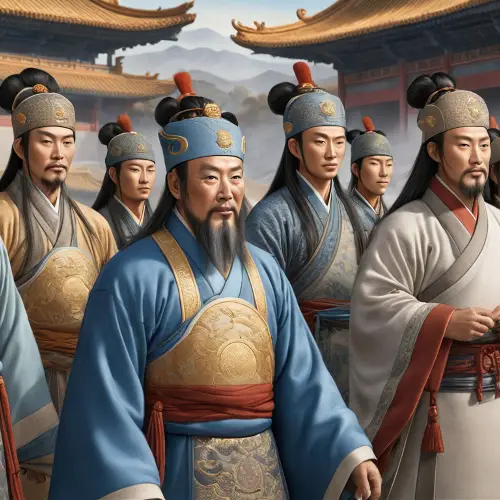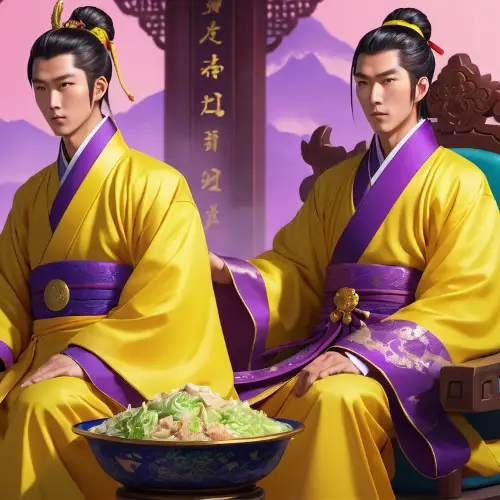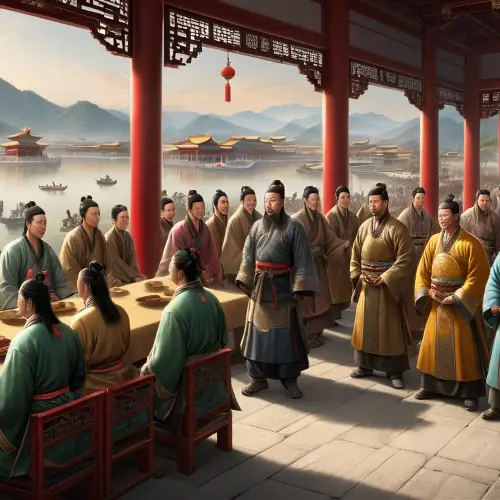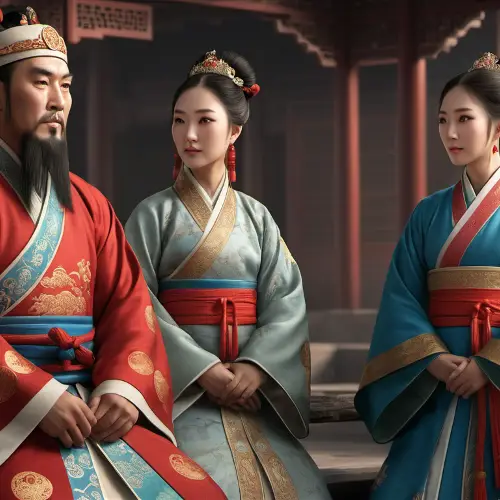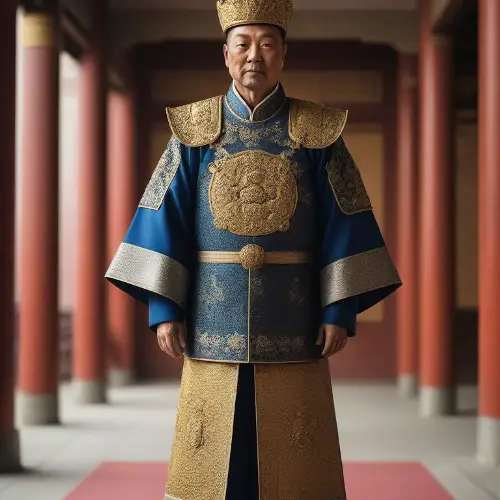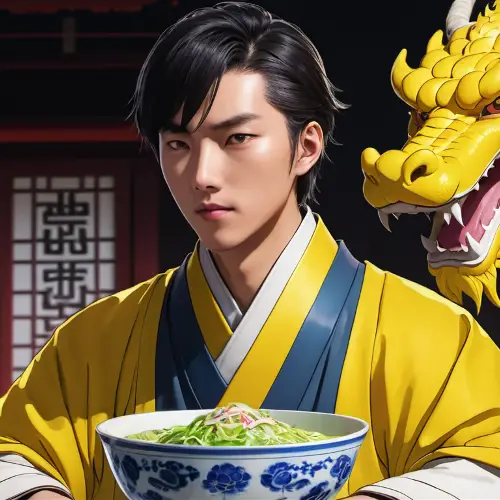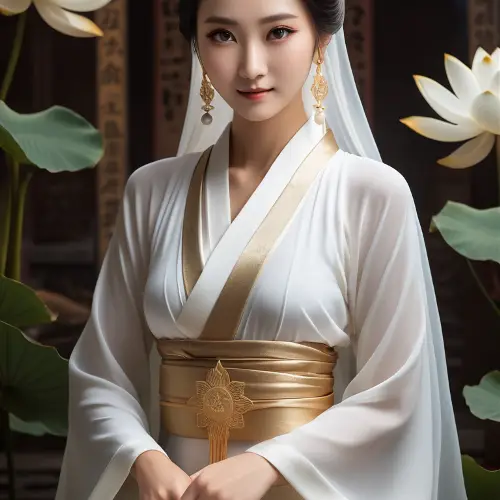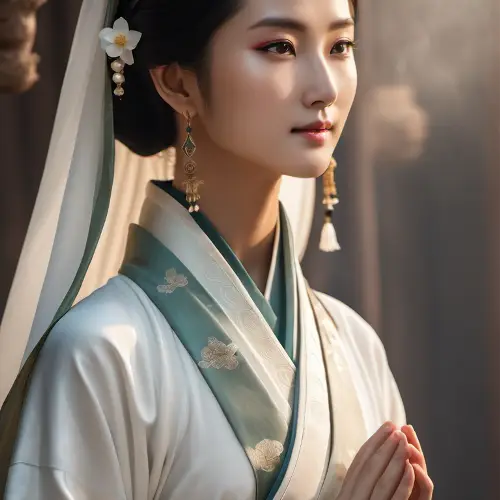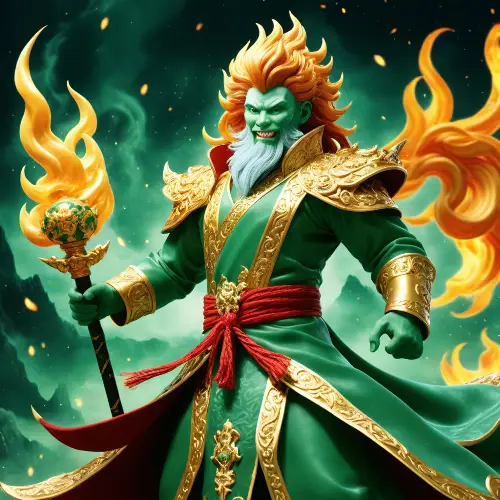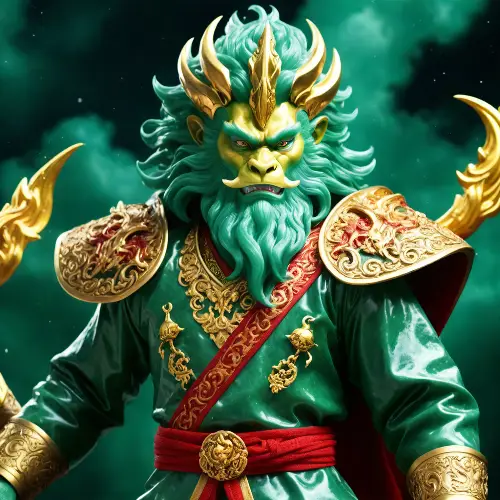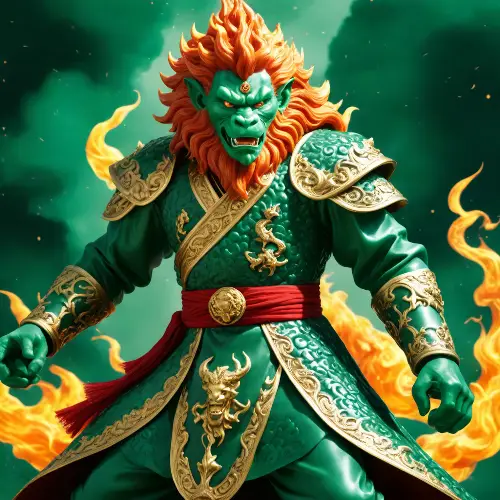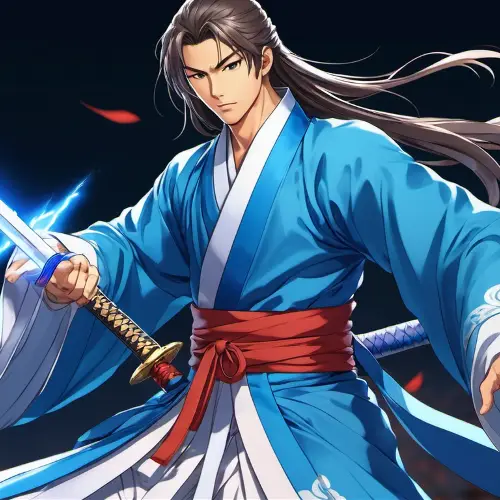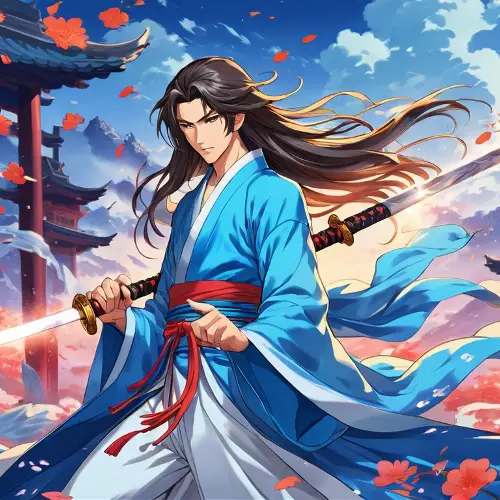In the Yongle Palace, a Taoist is standing in the center of the Sanqing Hall, and the murals around him, \"Chaoyuan Tu,\" seem to have come to life, moving with his movements. He was wearing a blue Taoist robe, with a plain white headscarf tied around his head. His face was delicate, and his eyes were deep. With a gentle wave of his wand, there seemed to be a subtle fluctuation in the air. Yongle Palace is a architectural treasure of the Yuan Dynasty in China, with every brick and tile filled with traces of history. The towering hall and exquisite carving all showcase the superb skills of Chinese meticulous painting. The murals here are hailed as treasures of the Oriental Gallery, and the Chaoyuan Painting is based on Taoist philosophy, depicting scenes of immortals casting spells by drawing inspiration from heaven and earth and nature. The Taoist began to cast spells, and every movement he made was as smooth as flowing clouds and water, as if blending with nature. With a gentle flick of his finger, a faint light flew out of his fingertips and headed straight towards the deity in the mural. The mural seemed to come to life, and the immortals began to move. Their movements echoed those of the Taoist, creating a beautiful scene.
More Like This
In the Yongle Palace, a Taoist is standing in the center of the Sanqing Hall, and the murals around him, \"Chaoyuan Tu,\" seem to have come to life, moving with his movements. He was wearing a blue Taoist robe, with a plain white headscarf tied around his head. His face was delicate, and his eyes were deep. With a gentle wave of his wand, there seemed to be a subtle fluctuation in the air. Stepping on a computer chip under his feet, the light rose from in front of him
In the Yongle Palace, a Taoist is standing in the center of the Sanqing Hall, and the murals around him, \"Chaoyuan Tu,\" seem to have come to life, moving with his movements. He was wearing a blue Taoist robe, with a plain white headscarf tied around his head. His face was delicate, and his eyes were deep. With a gentle wave of his wand, there seemed to be a subtle fluctuation in the air. Yongle Palace is a architectural treasure of the Yuan Dynasty in China, with every brick and tile filled with traces of history. The towering hall and exquisite carving all showcase the superb skills of Chinese meticulous painting. The murals here are hailed as treasures of the Oriental Gallery, and the Chaoyuan Painting is based on Taoist philosophy, depicting scenes of immortals casting spells by drawing inspiration from heaven and earth and nature. The Taoist began to cast spells, and every movement he made was as smooth as flowing clouds and water, as if blending with nature. With a gentle flick of his finger, a faint light flew out of his fingertips and headed straight towards the deity in the mural. The mural seemed to come to life, and the immortals began to move. Their movements echoed those of the Taoist, creating a beautiful scene.
In the Yongle Palace, a Taoist is standing in the center of the Sanqing Hall, and the murals around him, \"Chaoyuan Tu,\" seem to have come to life, moving with his movements. He was wearing a blue Taoist robe, with a plain white headscarf tied around his head. His face was delicate, and his eyes were deep. With a gentle wave of his wand, there seemed to be a subtle fluctuation in the air. Yongle Palace is a architectural treasure of the Yuan Dynasty in China, with every brick and tile filled with traces of history. The towering hall and exquisite carving all showcase the superb skills of Chinese meticulous painting. The murals here are hailed as treasures of the Oriental Gallery, and the Chaoyuan Painting is based on Taoist philosophy, depicting scenes of immortals casting spells by drawing inspiration from heaven and earth and nature. The Taoist began to cast spells, and every movement he made was as smooth as flowing clouds and water, as if blending with nature. With a gentle flick of his finger, a faint light flew out of his fingertips and headed straight towards the deity in the mural. The mural seemed to come to life, and the immortals began to move. Their movements echoed those of the Taoist, creating a beautiful scene.
In the Yongle Palace, a Taoist is standing in the center of the Sanqing Hall, and the murals around him, \"Chaoyuan Tu,\" seem to have come to life, moving with his movements. He was wearing a blue Taoist robe, with a plain white headscarf tied around his head. His face was delicate, and his eyes were deep. With a gentle wave of his wand, there seemed to be a subtle fluctuation in the air. Yongle Palace is a architectural treasure of the Yuan Dynasty in China, with every brick and tile filled with traces of history. The towering hall and exquisite carving all showcase the superb skills of Chinese meticulous painting. The murals here are hailed as treasures of the Oriental Gallery, and the Chaoyuan Painting is based on Taoist philosophy, depicting scenes of immortals casting spells by drawing inspiration from heaven and earth and nature. The Taoist began to cast spells, and every movement he made was as smooth as flowing clouds and water, as if blending with nature. With a gentle flick of his finger, a faint light flew out of his fingertips and headed straight towards the deity in the mural. The mural seemed to come to life, and the immortals began to move. Their movements echoed those of the Taoist, creating a beautiful scene.
In the Yongle Palace, a Taoist is standing in the center of the Sanqing Hall, and the murals around him, \"Chaoyuan Tu,\" seem to have come to life, moving with his movements. He was wearing a blue Taoist robe, with a plain white headscarf tied around his head. His face was delicate, and his eyes were deep. With a gentle wave of his wand, there seemed to be a subtle fluctuation in the air. Stepping on a computer chip under his feet, the light rose from in front of him
Cloaked in a pure white robe with a sword hanging at his waist, he appears like a wanderer of all realms. His tall and slender figure moves with lightness, seemingly detached from the earthly realm. A deep blue Taoist hat gently veils his clear and profound eyes, which hold the richness of life experiences; each blink echoes with contemplation. In his hands, he wields a broad and ancient sword, its blade engraved with the marks of passing ages. The tip of the sword flickers with a subtle glint of cold light, resembling distant stars, exuding a profound sense of solemnity. In the display of his swordsmanship, each move resonates like a melodious tune, reminiscent of a harmonious and exhilarating martial arts ballad. There's a mysterious aura about him, as if he were a recluse dwelling in mountainous forests; his presence is akin to an ancient temple washed by time, radiating an inviolable solemnity.
Cloaked in a pure white robe with a sword hanging at his waist, he appears like a wanderer of all realms. His tall and slender figure moves with lightness, seemingly detached from the earthly realm. A deep blue Taoist hat gently veils his clear and profound eyes, which hold the richness of life experiences; each blink echoes with contemplation. In his hands, he wields a broad and ancient sword, its blade engraved with the marks of passing ages. The tip of the sword flickers with a subtle glint of cold light, resembling distant stars, exuding a profound sense of solemnity. In the display of his swordsmanship, each move resonates like a melodious tune, reminiscent of a harmonious and exhilarating martial arts ballad. There's a mysterious aura about him, as if he were a recluse dwelling in mountainous forests; his presence is akin to an ancient temple washed by time, radiating an inviolable solemnity.
Cloaked in a pure white robe with a sword hanging at his waist, he appears like a wanderer of all realms. His tall and slender figure moves with lightness, seemingly detached from the earthly realm. A deep blue Taoist hat gently veils his clear and profound eyes, which hold the richness of life experiences; each blink echoes with contemplation. In his hands, he wields a broad and ancient sword, its blade engraved with the marks of passing ages. The tip of the sword flickers with a subtle glint of cold light, resembling distant stars, exuding a profound sense of solemnity. In the display of his swordsmanship, each move resonates like a melodious tune, reminiscent of a harmonious and exhilarating martial arts ballad. There's a mysterious aura about him, as if he were a recluse dwelling in mountainous forests; his presence is akin to an ancient temple washed by time, radiating an inviolable solemnity.
Building 17 at Wuhan Business and Trade Vocational College, affectionately referred to as \Xinhe Yuan,\ stands as the designated residence for male students. Designed in the distinctive configuration of a square-shaped H, this seven-story architectural marvel showcases a harmonious blend of terracotta red and off-white tiles, accentuated by an encircling verdant tapestry. The integration of lush greenery, both within and around the structure, elevates the overall aesthetic. Xinhe Yuan not only serves as a dwelling but also as a canvas for the collaborative artistic expression of its inhabitants, transforming the environment into a living masterpiece reminiscent of a vibrant and welcoming artistic community.There must be three words \信和苑\ in the picture
A Chinese Taoist wearing a Daoist robe standing on a cliff, an authentic photo as much as possible.
In this luminous painting, Kublai of the Yuan Dynasty sits majestically at a large wooden desk, overseeing scholars meticulously compiling the Da Yuan Yitong Zhi. The image unfolds in warm tones of ochre and amber, capturing the essence of cultural fusion. Brushstrokes reminiscent of classical Chinese art elegantly depict the emperor's majestic face and the scholars' diligent efforts. Soft diffused light bathes the scene, casting a soft glow over the ornate manuscripts and creating an atmosphere of reverence and historical scholarship.
Xinhe Yuan, Building 17 at Wuhan Business and Trade Vocational College, is a true masterpiece that captivates the hearts of all who behold it. This designated residence for male students stands tall and proud, showcasing its distinctive configuration in the shape of a square-shaped H. Its seven stories reach towards the heavens, as if aspiring to touch the sky. The exterior of Xinhe Yuan is adorned with a captivating blend of terracotta red and off-white tiles, creating a visual symphony of colors that is both striking and elegant. These colors are further enhanced by the encircling verdant tapestry that embraces the building, as if nature itself has woven a frame around this architectural marvel. But Xinhe Yuan is not merely a structure of concrete and tiles; it is a living testament to the power of artistic expression. Within its walls, an artistic community thrives, each resident contributing their unique vision to transform the environment into a living masterpiece. The corridors are adorned with vibrant paintings, reflecting the creativity and passion of its inhabitants. Sculptures and installations dot the landscape, breathing life into every nook and cranny. As you step inside Xinhe Yuan, you are immediately greeted by an explosion of greenery. A lush garden fills the central courtyard, a vibrant oasis amidst the bustling campus. Here, students gather to find solace and inspiration, surrounded by a symphony of colors and textures. The leaves rustle in the gentle breeze, creating a soothing melody that resonates with the souls of those who walk these hallowed halls. The interior of Xinhe Yuan is a testament to the harmonious coexistence of nature and architecture. Sunlight pours through large windows, casting a warm glow upon the polished floors. The walls are adorned with murals depicting scenes of nature and the human experience, blurring the boundaries between art and life. Every inch of the building is infused with a sense of vitality and creativity, nourishing the spirits of those who call this place home. In the evenings, as the sun begins its descent, Xinhe Yuan takes on a different aura. The warm hues of the terracotta tiles are bathed in a soft golden light, creating a scene straight out of a dream. Shadows dance along the corridors, imbuing the atmosphere with a sense of mystery and enchantment. It is during this magical time that the true essence of Xinhe Yuan is revealed, a place where imagination knows no bounds and artistic expression flourishes. If Xinhe Yuan were to be captured in a photograph, it would be through the lens of a wide-angle camera, capturing the grandeur and scale of the building. The photograph would exude a timeless quality, with a touch of vintage charm. The film used would be one that enhances the vibrant colors and adds a hint of nostalgia, reminiscent of an era where art and creativity reigned supreme. Xinhe Yuan, Building 17 at Wuhan Business and Trade Vocational College, is not just a residence for male students. It is a sanctuary for creativity, a haven for artistic souls to come together and create something truly extraordinary. It stands as a testament to the power of art to transform spaces and touch the hearts of all who encounter it.
Xinhe Yuan, Building 17 at Wuhan Business and Trade Vocational College, is a true masterpiece that captivates the hearts of all who behold it. This designated residence for male students stands tall and proud, showcasing its distinctive configuration in the shape of a square-shaped H. Its seven stories reach towards the heavens, as if aspiring to touch the sky. The exterior of Xinhe Yuan is adorned with a captivating blend of terracotta red and off-white tiles, creating a visual symphony of colors that is both striking and elegant. These colors are further enhanced by the encircling verdant tapestry that embraces the building, as if nature itself has woven a frame around this architectural marvel. But Xinhe Yuan is not merely a structure of concrete and tiles; it is a living testament to the power of artistic expression. Within its walls, an artistic community thrives, each resident contributing their unique vision to transform the environment into a living masterpiece. The corridors are adorned with vibrant paintings, reflecting the creativity and passion of its inhabitants. Sculptures and installations dot the landscape, breathing life into every nook and cranny. As you step inside Xinhe Yuan, you are immediately greeted by an explosion of greenery. A lush garden fills the central courtyard, a vibrant oasis amidst the bustling campus. Here, students gather to find solace and inspiration, surrounded by a symphony of colors and textures. The leaves rustle in the gentle breeze, creating a soothing melody that resonates with the souls of those who walk these hallowed halls. The interior of Xinhe Yuan is a testament to the harmonious coexistence of nature and architecture. Sunlight pours through large windows, casting a warm glow upon the polished floors. The walls are adorned with murals depicting scenes of nature and the human experience, blurring the boundaries between art and life. Every inch of the building is infused with a sense of vitality and creativity, nourishing the spirits of those who call this place home. In the evenings, as the sun begins its descent, Xinhe Yuan takes on a different aura. The warm hues of the terracotta tiles are bathed in a soft golden light, creating a scene straight out of a dream. Shadows dance along the corridors, imbuing the atmosphere with a sense of mystery and enchantment. It is during this magical time that the true essence of Xinhe Yuan is revealed, a place where imagination knows no bounds and artistic expression flourishes. If Xinhe Yuan were to be captured in a photograph, it would be through the lens of a wide-angle camera, capturing the grandeur and scale of the building. The photograph would exude a timeless quality, with a touch of vintage charm. The film used would be one that enhances the vibrant colors and adds a hint of nostalgia, reminiscent of an era where art and creativity reigned supreme. Xinhe Yuan, Building 17 at Wuhan Business and Trade Vocational College, is not just a residence for male students. It is a sanctuary for creativity, a haven for artistic souls to come together and create something truly extraordinary. It stands as a testament to the power of art to transform spaces and touch the hearts of all who encounter it.
An image of a Chinese emperor wearing a dragon robe standing alone inside an ancient Chinese imperial palace. The emperor should exude solemnity and authority, showcasing his ruling status. The palace should create a majestic and splendid atmosphere, highlighting its historical and cultural significance. Use moderate lighting to highlight the emperors figure and ensure clear visibility of the palaces details.
Rendered in meticulous watercolor strokes, Kublai Lie commands the compilation of the \"Unification of the Yuan Dynasty.\" The painting exhibits a harmonious blend of vibrant hues, portraying the emperor surrounded by scholars in an atmosphere of intellectual synergy. The translucent layers of watercolor evoke a sense of fluidity, symbolizing the integration of cultural elements. Kublai Lie's visage is characterized by a mix of determination and wisdom, capturing the essence of a ruler deeply invested in preserving knowledge. The scene exudes a serene ambiance, accentuating the cultural significance of the moment.
Imagine an image of a Chinese emperor standing alone inside an ancient Chinese imperial palace, dressed in a dragon robe. The emperor should exude solemnity and authority, showcasing his ruling status. The palace should create a majestic and splendid atmosphere, highlighting its historical and cultural significance. Use moderate lighting to emphasize the emperors figure and ensure the palaces intricate details are clearly visible.
The camera moves to an ancient palace, where Zhu Yuanzhang sits on the dragon throne. He is wearing a yellow dragon robe from the Ming Dynasty, and on the coffee table in front of him is a small bowl of cabbage tofu soup. The lighting is soft and of high quality. This shot is a close-up, reminiscent of the style of Bubble supermarket.
Transitioning to a historical tableau, this oil painting delicately captures the highly distinctive period of the Yuan Dynasty in Chinese history, founded by the Mongols as a feudal dynasty succeeding the Song Dynasty. Rich textures and a unique blend of colors characterize the scene, portraying elements that define the distinct characteristics of the Yuan Dynasty. The color palette harmonizes traditional Chinese hues with Mongolian influences, reflecting the cultural amalgamation. Facial expressions mirror a mix of adaptation and cultural synthesis, illuminated by the soft, diffused light that bathes this distinctive era. The painting eloquently conveys the unique beauty of the Yuan Dynasty
She is dressed in an elegant qipao, the silky fabric gently swaying in the breeze. The patterns and colors on the qipao resemble a delicate painting, showcasing the beauty of traditional Chinese art. Her hair is neatly arranged into a simple yet refined updo, adorned with a subtle flower, adding a touch of freshness to the overall look. Her facial features are exquisite, with delicate skin radiating a natural glow. Bright and lively eyes, with a profound gaze reminiscent of bright stars in the night sky. The slightly upturned corners of her mouth reveal confidence and elegance, evoking a sense of admiration. Her attire combines tradition with modernity, displaying a unique personality. The details of the accessories are refined and meticulous, showcasing her keen sense of fashion. The entire ensemble is a perfect blend of tradition and modernity, eloquently expressing her respect for cultural traditions while exuding charm in the sea of fashion. This beautifully dressed Chinese girl is not only elegantly adorned but also uniquely combines cultural tradition with contemporary style, revealing a captivating charm.
Channeling the historical charm, this watercolor illustration delicately portrays the establishment of the Yuan Dynasty, intricately linked to the Mongol conquests and the subsequent far-reaching changes in Chinese history. Executed with gentle strokes and a harmonious color palette, the scene unfolds with symbolic elements representing the transformative nature of this chapter. Soft blues and warm hues accentuate the seamless blend of cultural synthesis. Facial expressions convey a mix of resilience and adaptation, bathed in the gentle light that marks this transformative historical era. The watercolor elegantly communicates the unique charm of the Yuan Dynasty's impact on Chinese history
Building 17 at Wuhan Business and Trade Vocational College, affectionately referred to as \Xinhe Yuan,\ stands as the designated residence for male students. Designed in the distinctive configuration of a square-shaped H, this seven-story architectural marvel showcases a harmonious blend of terracotta red and off-white tiles, accentuated by an encircling verdant tapestry. The integration of lush greenery, both within and around the structure, elevates the overall aesthetic. Xinhe Yuan not only serves as a dwelling but also as a canvas for the collaborative artistic expression of its inhabitants, transforming the environment into a living masterpiece reminiscent of a vibrant and welcoming artistic community.There must be three Chinese characters for \信和苑\ in the picture
\In ancient China, amidst the mountain valleys with towering peaks and winding paths, there stood the silhouette of a young Taoist priest. Draped in a white robe, he carried a dusted staff, emanating an ethereal and otherworldly presence.\
This painting transitions into a historical image that delicately captures the imperial edicts of the Chinese Yuan Dynasty Emperor Kublai compiling the Great Unification of the Yuan Dynasty Compendium. The image is rich in texture and soft in color, depicting the bookishness of the compilation process. The color palette reconciles majestic tones with bookishness, reflecting the fusion of imperial power and intellectual pursuits. The facial expressions are firm and focused against the soft, diffused light. The painting eloquently conveys the imperial directive to consolidate Yuan rule.
An ancient palace, with a Chinese emperor sitting on a throne. He was wearing a yellow robe from the Ming Dynasty, with a dragon pattern on it. There was a bowl of cabbage soup on the coffee table in front of him. The lighting is soft and of high quality. This scene is a close-up, reminiscent of the style of Bubble Mart.
This painting is a fascinating display of history, delicately depicting the establishment of the Yuan Dynasty, which is intricately linked to the Mongol conquest and the subsequent far-reaching changes in Chinese history. The image unfolds with soft brushstrokes and harmonious tones, with symbolic elements representing the transformative nature of this chapter. Soft blues and warm tones highlight the seamless integration of cultural synthesis. Facial expressions convey a mixture of resilience and adaptability, bathed in the soft light that marks this transformative time in history. This watercolor elegantly conveys the unique influence of the Yuan Dynasty on Chinese history
The camera turns towards an ancient palace, with Zhu Yuanzhang sitting on the dragon throne. He is wearing a yellow dragon robe from the Ming Dynasty, with a bowl of cabbage and tofu soup in front of him. The background is bright purple, with soft and high-quality lighting. This shot is a close-up, reminiscent of the style of Bubble Mart.
This painting depicts with delicate brushstrokes the historical scene of the establishment of the Yuan Dynasty by the Mongol Khan Kublai. Richly textured and brightly colored, the painting depicts Kublai's capture of Lin'an (present-day Hangzhou) as the capital of the Southern Song Dynasty. The color palette harmonizes traditional Chinese tones with Mongolian styles, reflecting a fusion of cultures. Facial expressions reflect a mixture of triumph and determination, and soft diffused light illuminates this pivotal moment in history. The painting eloquently conveys the history of the Yuan dynasty's formal unification of China in 1271.
A scene of an ancient Chinese emperor standing alone inside a Chinese imperial palace. The emperor should exude dignity and power, showcasing his ruling status. The ancient palace in the image should create an atmosphere of solemnity and grandeur, highlighting its historical and cultural value. Use appropriate lighting to accentuate the emperors figure while keeping the palaces details clear and visible.
The camera pans towards an ancient palace, where Zhu Yuanzhang is sitting on the dragon throne. He is wearing a yellow dragon robe from the Ming Dynasty, with a bowl of cabbage and tofu soup in front of him. The lighting is soft and of high quality. This shot is a close-up, reminiscent of the style of Bubble mart.
ink painting style, rice paper,Guanyin Bodhisattva, ethereal, celestial aura, serene, lotus throne, flowing white robes, holding branch, compassion in eyes, tranquil smile, pearl of wisdom, surrounded by gentle light,cross-legged, setting in a sacred temple, calm water body, lotus flowers, incense smoke, ancient Buddhist symbols, carved stone decorations dunhuang_style, dunhuang_cloths,beautiful eyes,radiance behind, (veil),front, text, halo,, (masterpiece:1. 0), (best quality:1. 3), (ultra highres:1. 2), (intricate details:1.3) ,1girl
Enchantress draped in ethereal allure, embodying the essence of ancient China. A resplendent palette of rich, regal hues adorns her attire, a seamless dance of sophistication. The Rev Animated model, with its mesmerizing movements, captures the graceful cadence of her every step, bringing life to the canvas. Standing proudly in a frontal pose, her entire being emanates an air of mystery and charm. Her garments, a harmonious blend of traditional elegance and modern flair, cascade in intricate folds, echoing tales of dynasties past. The color scheme, a tapestry of opulent golds, deep crimsons, and subtle jade, evokes a sense of high refinement. The animated strokes breathe vitality into her form, as if she were stepping out of an ancient scroll into the present moment. This enchanting portrait, a celebration of Chinese aesthetics, captures the spirit of a timeless enchantress in the full splendor of her regal attire. (Resolution: 8k, Chinese Opulence: 1.8, Rev Animated Model: On, Color Harmony: Gold-Crimson-Jade, Pose: Frontal, Dimensions: 1080x1920, Model: enchantingdynasty_8, Negative Prompt: MundanePast, FastNegativeV2 seed: 12082023)
This distinctive Rat figure exudes a strong and fierce presence. Its robust physique is accentuated by a scar on its left cheek, symbolizing bravery and toughness. It sports a pair of Chinese-style carved sunglasses with cloud patterns embellishing the arms, adding an air of mystery. Adorned in a traditional Chinese gown embroidered with dragon and phoenix motifs, it also wears a necklace strung with copper coins tied by a red cord, reflecting its profound cultural heritage and rugged demeanor. At this moment, it sits confidently on an antique Chinese armchair, leisurely crossing one leg over the other, while firmly gripping a smoking revolver that has just been fired, demonstrating immense power and fearlessness. The background showcases a unique Eastern ambiance, featuring a scene combining elements of classical architecture and landscape painting with swaying red lanterns and fluttering talismans, creating a rich and distinctively Oriental atmosphere.
This distinctive Rat figure exudes a strong and fierce presence. Its robust physique is accentuated by a scar on its left cheek, symbolizing bravery and toughness. It sports a pair of Chinese-style carved sunglasses with cloud patterns embellishing the arms, adding an air of mystery. Adorned in a traditional Chinese gown embroidered with dragon and phoenix motifs, it also wears a necklace strung with copper coins tied by a red cord, reflecting its profound cultural heritage and rugged demeanor. At this moment, it sits confidently on an antique Chinese armchair, leisurely crossing one leg over the other, while firmly gripping a smoking revolver that has just been fired, demonstrating immense power and fearlessness. The background showcases a unique Eastern ambiance, featuring a scene combining elements of classical architecture and landscape painting with swaying red lanterns and fluttering talismans, creating a rich and distinctively Oriental atmosphere.
This distinctive Rat figure exudes a strong and fierce presence. Its robust physique is accentuated by a scar on its left cheek, symbolizing bravery and toughness. It sports a pair of Chinese-style carved sunglasses with cloud patterns embellishing the arms, adding an air of mystery. Adorned in a traditional Chinese gown embroidered with dragon and phoenix motifs, it also wears a necklace strung with copper coins tied by a red cord, reflecting its profound cultural heritage and rugged demeanor. At this moment, it sits confidently on an antique Chinese armchair, leisurely crossing one leg over the other, while firmly gripping a smoking revolver that has just been fired, demonstrating immense power and fearlessness. The background showcases a unique Eastern ambiance, featuring a scene combining elements of classical architecture and landscape painting with swaying red lanterns and fluttering talismans, creating a rich and distinctively Oriental atmosphere.
\"In the epic tapestry of legend, Sun Wukong, the indomitable Monkey King, strides forth with an unbridled aura of power. His golden mane, a torrent of celestial flames, cascades with the ferocity of a cosmic inferno. His eyes, ablaze with the legendary Fire Eyes, pierce through realms, revealing the profound wisdom within. Beneath a crown of jade-green fangs, his countenance exudes a captivating mix of mischief and regality. Draped in robes of regal azure and molten gold, every fold whispers the majesty of a celestial conqueror. The Ruyi Jingu Bang, his enchanted staff, an extension of his cosmic dominance, extends to the heavens. From head to toe, his form radiates the essence of the Great Sage, a mythic force of nature. The backdrop, a canvas of swirling clouds and towering peaks, echoes the resounding tales of Sun Wukong's epic journey. (Resolution: 4k, Celestial Inferno Mane: 2.5, Fire Eyesight: 2.0, Jade-green Fangs Countenance: 1.8) \\u003clora:more_details:0.8\\u003e Mythic force, wielder of the cosmic staff, Seed: 2022052201, Dimensions: 3840x2160, Sampler: cosmicWukong_4k, Inference Steps: 80, Guidance Scale: 9, Model: celestialtyrant_4, Clip Skip: yes, VAE: vae-cosmicWukong-1000000-ema-pruned, Negative Prompt: MundaneMemory, FastNegativeV2 seed:5222022\"
\"In the epic tapestry of legend, Sun Wukong, the indomitable Monkey King, strides forth with an unbridled aura of power. His golden mane, a torrent of celestial flames, cascades with the ferocity of a cosmic inferno. His eyes, ablaze with the legendary Fire Eyes, pierce through realms, revealing the profound wisdom within. Beneath a crown of jade-green fangs, his countenance exudes a captivating mix of mischief and regality. Draped in robes of regal azure and molten gold, every fold whispers the majesty of a celestial conqueror. The Ruyi Jingu Bang, his enchanted staff, an extension of his cosmic dominance, extends to the heavens. From head to toe, his form radiates the essence of the Great Sage, a mythic force of nature. The backdrop, a canvas of swirling clouds and towering peaks, echoes the resounding tales of Sun Wukong's epic journey. (Resolution: 4k, Celestial Inferno Mane: 2.5, Fire Eyesight: 2.0, Jade-green Fangs Countenance: 1.8) \\u003clora:more_details:0.8\\u003e Mythic force, wielder of the cosmic staff, Seed: 2022052201, Dimensions: 3840x2160, Sampler: cosmicWukong_4k, Inference Steps: 80, Guidance Scale: 9, Model: celestialtyrant_4, Clip Skip: yes, VAE: vae-cosmicWukong-1000000-ema-pruned, Negative Prompt: MundaneMemory, FastNegativeV2 seed:5222022\"
Captured through the lens of a vintage 35mm camera, Kublai Lie directs the compilation of the \"Unification of the Yuan Dynasty.\" The photograph, awash in sepia tones, conveys a timeless quality, emphasizing the historical importance of the moment. The composition skillfully frames the emperor amidst a bustling scholarly environment, with a shallow depth of field highlighting the focused activity. Kublai Lie's stoic expression reflects his commitment to preserving China's rich history. The natural light streaming through antique windows adds an authentic touch, evoking a sense of historical documentation.
Elegant Chinese beauty, wearing a traditional qipao with delicate embroidered patterns, her hair adorned with classic hairpins, standing gracefully in a serene ancient Chinese garden, surrounded by blooming peonies and a tranquil pond, painted in a vibrant yet tasteful color palette, High resolution, --ar 3:4
In a world of cultivating immortals, a handsome man wears a matching white and blue Chinese-style robe with a fluttering skirt, fair skin, and long hair. He has an expression of no anger and self-power, and his whole body exudes an aura of looking down on the world. , holding a long sword in his hand, the blade of the sword flashed with cold light, and the tip of the sword pointed at a group of people kneeling on the ground seed:1976761871



